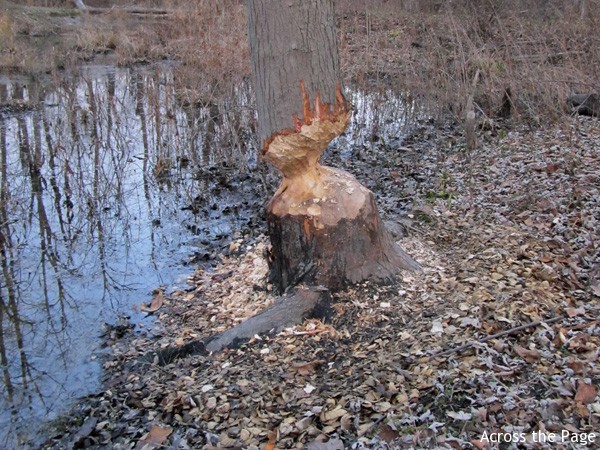 Freud believed that we push unpleasant things out of our awareness when we deem them unacceptable, but these unwanted impulses and thoughts come sneaking back around looking always for some other way in. These are usually things that are so horrible we can’t even tolerate their mere existence, like I want to kill my baby brother or I really want to have sex with my mother, for example.
Freud believed that we push unpleasant things out of our awareness when we deem them unacceptable, but these unwanted impulses and thoughts come sneaking back around looking always for some other way in. These are usually things that are so horrible we can’t even tolerate their mere existence, like I want to kill my baby brother or I really want to have sex with my mother, for example.
And hey, speaking of the return of truly intolerable things, Herb Bergquist has written another letter to the editor about the Upton-beaver-dragonfly bru-haha.
I would like to respectfully provide a slightly different perspective to the one presented in the article: “Huebner: Out-smarting Upton’s beavers” (Dec. 9).
While the MSPCA & HSUS continue to claim that trapping is not a long-term solution to beaver (or coyote) related conflicts, they have inadvertently created a self-fulfilling prophecy by restricting lethal trapping to last resort, desperate measure scenarios. For many, this simplistic black & white approach has resulted in the polarization of positions on both sides of the issue.
Those polarizing beaver protectors! You can read Linda’s letter here. You will remember that Mr. B is the former UFS employee who started the Committee for Responsible Wildlife Management in Massachusetts (no link on purpose although his website DOES have the delightful mistake of a “supporting wildlife organization” that links to porn….ahh…) He has been working day and night to overturn the humane trapping restrictions. (Back story: in 1996 the state passed a ban against using conibear traps UNLESS certain conditions were met, in which case all bets were off. In “typical” trapping situations, beaver must be live trapped ‘humanely’ and then shot in the head or gassed to death, whereas when property or roads or waterways are threatened, all manner of body crushing traps may be deployed.
Our state is in a position where rather large beaver populations exist in areas that eventually cause problems – which we can all agree upon. A reasonable, all inclusive approach would be to reduce those populations proactively, before problems occur and modify the current law to allow for this to happen. This is what wildlife managers do in a regulated way; it is not extermination. The current, status quo system forces these wild populations to naturally expand in size and then pushes the boundaries of occupying optimal natural habitat beyond what can support them comfortably.
How is it not extermination to kill something so that it doesn’t reproduce enough to make more of itself? Could this be a new slogan for Orkin? Every time Mr. B or anyone else complains that beaver can’t be adequately killed without enough cruelty they fail to mention that cruelty is entirely allowed with consent from the Health Department and no health department in the history of the world has ever been reported to NOT give consent. No matter. The real issue isn’t numbers or methods. It’s that hiring a trapper with a conibear costs a couple hundred dollars. Hiring a trapper with live traps costs more. And so property owners handle the problem themselves with a shotgun and nobody gets hired.
Especially not Mr. B which – makes him very unhappy.
The “Outsmarting Beavers in Upton” article touts the successful implementation of over 800 operational and maintained water leveling devices across the state. If we were to average the installation of these devices to just $1500 per device, that’s 1.2 million dollars – not to mention maintenance! And we still have perpetual problems and costs that dwarf that number! Should we just keep telling people to invest in flow devices and then decide if it’s the best solution? What the advocates of these devices don’t tell you is that they don’t work in all situations and some trapping must occur even in the best of locations. Ironically, the overuse of beaver flow devices may just be feeding the self-fulfilling prophecy that lethal trapping does not work! So, if flow devices are our only proactive solution, it makes sense to advocate for more of them. Where the overuse or inappropriate use of the devices occur, we are essentially creating “concentration camp” conditions for beavers – is that what we want? In this case, I would agree beaver populations are self-regulating… just like every living thing on earth. Long-term solutions require both lethal and non-lethal proactive approaches and work hand in hand. Creating a one-size-fits-all system has failed miserably at the costly expense to both people and wildlife.
Bonus points for invoking the “concentration camp for beavers” imagery! That’s quite a twofer. You’ll horrify huggers and jews very nicely! So his letter tramples over the “compassionistas” and anyone who installs flow devices and leaves a crumpled muddy trail through the good intentions the state may once have had. In the meantime we are asked to believe that solving problems using individually constructed flow devices is a one-size-fits-all solution while killing everybeaver in question is complex and layered.
For the record, I have read complaints this year that beaver populations are “higher than any other state” from Iowa, Texas and Oregon – (none of who have trapping bans and none of whom have any real idea whatsoever of how their state compares). We all know folks lie when it comes to beavers. That’s nothing new. It does seem that Mr. B’s lies have gotten a little more sloppy than usual, his metaphors a little more alienating, his common touch a little less common and a little more touchy.
Prompting the obvious question, is everything okay, Herbie?


![li-nb-moncton-wetland[1]](https://www.martinezbeavers.org/wordpress/wp-content/uploads/2011/12/li-nb-moncton-wetland1.jpg)

![napa-wineries-map[1]](https://www.martinezbeavers.org/wordpress/wp-content/uploads/2011/12/napa-wineries-map1.gif)












































